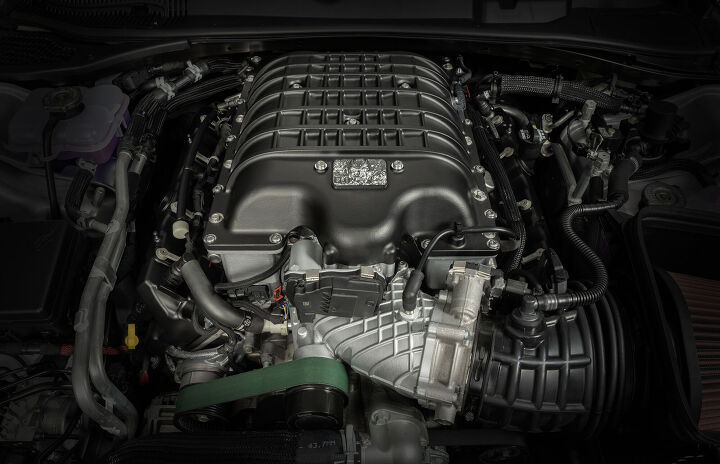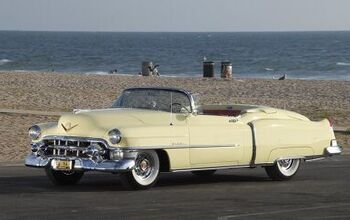Report: Stellantis Discusses Engine Plans

With Stellantis vowing to launch a slew of all-electric and hybrid vehicles by 2030, many are wondering how this will impact the lineup in North America. The company has repeatedly alluded to eliminating the HEMI V8 in favor of the more-European Hurricane 3.0-liter straight-six. While this is clearly being done to comply with emissions regulations without having to sacrifice power, plenty have bemoaned the company’s decision to abandon V8 powertrains whilst pivoting toward electrification.
But Micky Bly, senior vice president and head of global propulsion systems for Stellantis, recently assured the public that the company doesn’t intend on dumping combustion engines overnight. It’s even going to keep a few of Chrysler’s oldest units around — just with some improvements designed to meet the relevant emissions standards.
"When we came together as two families, PSA and FCA, we had a lot of engines,” the executive was quoted as saying by Automotive News on Wednesday. “We are rapidly streamlining our three-cylinder, four-cylinder and six-cylinder and even our eight-cylinder engines. We are aggressively streamlining our diesel portfolio. We already exited the 3.0-liter diesel. We will have a low-displacement diesel and a big diesel that's coming in the future."
Stellantis wants to have 75 EVs on sale globally by the end of the decade.
"We have to balance this approach,” said Mr. Bly. “ ICE is here to stay for a period of time. We are growing capacity, adding capacity, for South America, the Middle East and Europe and Asia Pacific.”
From Automotive News:
As for the U.S., Bly said Stellantis' strategy will see new engines and improved versions of current gasoline powertrains.
"One of the things that was very clear [in the merger of PSA Group and Fiat Chrysler Automobiles] was that we had some engines that were not performing well on our C02 road map," he said. "We could fix some of those things with [mild and plug-in hybrids]. The Hemi doesn't have all the attributes we needed. We could go and redo the Hemi, but we realized we needed to downsize the engine and bring up the power."
That happened late last year with the introduction of the 3.0-liter Hurricane twin-turbo inline six-cylinder, which makes more power than the bigger, heavier 6.4-liter Hemi V-8. A high-output version of the Hurricane makes 520 hp, 35 hp more than the Hemi V-8. "We have more power. We just haven't released it yet," said Bly.
Losing the HEMI will remain a serious blow to some MOPAR fans. V8 motors are often seen as iconically American and there will be some prospective customers who will feel uneasy about losing a large, naturally aspirated motor for a smaller, more-complicated unit sporting forced induction. Properly cared for examples of Stellantis’ older V8 powertrain have surpassed 200,000 miles, whereas the inline-six is an unknown quantity reliant on turbocharging to make additional power.
But the manufacturer is already having trouble adhering to American regulations and likely couldn’t make good use of the V8 outside of the United States or Canada anyway. Keep in mind that the merger between Fiat Chrysler Automobiles and PSA Group that created Stellantis has only upped the European influence.
Corporate leadership made it crystal clear that those newly acquired American brands (e.g. Dodge, Jeep, Chrysler, RAM) would need to prove themselves viable if they were to continue existing. But Stellantis is also trying to prioritize synergy on a global scale, meaning there needs to be more overlap between its tiny-engined European cars and our hulking American behemoths.
It’s a scheme literally every company that’s bought up Chrysler has had trouble making work. However, it’s probably unavoidable since we’ve seen Ford and General Motors likewise prioritize smaller motors while pursuing a more global mindset. Besides, the United States is already echoing some of the regulatory jargon we’ve been seeing from Europe and President Biden has made it a priority to transition the country to all-electric vehicles as quickly as possible — regardless of how ready the relevant technologies, charging infrastructure, or consumers happen to be.
Stellantis is downsizing powertrains and has confirmed that the 3.0-liter Hurricane will get a smaller, 2.0-liter counterpart boasting just four cylinders. Automotive News also reported that there’s a three-cylinder version on the way that’s supposedly based on a preexisting European motor.
However, Bly did say that the Pentastar V6 would be sticking around – noting that the Hurricane was technically small enough to replace it. Considering how compact V6 motors tend to be on average vs I-6 motors, that’s a pretty serious brag. But the Pentastar will see some updates, including hybridization.
"The Pentastar is a very good, lower-cost, rock-solid, high-quality stalwart of our collection, and we have no plans to replace it. In fact, shortly, you will hear of an improvement coming, and it will be a bit of an electrification story,” stated Bly.
[Image: Stellantis]
Become a TTAC insider. Get the latest news, features, TTAC takes, and everything else that gets to the truth about cars first by subscribing to our newsletter.

A staunch consumer advocate tracking industry trends and regulation. Before joining TTAC, Matt spent a decade working for marketing and research firms based in NYC. Clients included several of the world’s largest automakers, global tire brands, and aftermarket part suppliers. Dissatisfied with the corporate world and resentful of having to wear suits everyday, he pivoted to writing about cars. Since then, that man has become an ardent supporter of the right-to-repair movement, been interviewed on the auto industry by national radio broadcasts, driven more rental cars than anyone ever should, participated in amateur rallying events, and received the requisite minimum training as sanctioned by the SCCA. Handy with a wrench, Matt grew up surrounded by Detroit auto workers and managed to get a pizza delivery job before he was legally eligible. He later found himself driving box trucks through Manhattan, guaranteeing future sympathy for actual truckers. He continues to conduct research pertaining to the automotive sector as an independent contractor and has since moved back to his native Michigan, closer to where the cars are born. A contrarian, Matt claims to prefer understeer — stating that front and all-wheel drive vehicles cater best to his driving style.
More by Matt Posky
Latest Car Reviews
Read moreLatest Product Reviews
Read moreRecent Comments
- Olivehead The Honda Civic wins on looks and interior material quality and style. The Civic looks like a scaled down "real" car (i.e., midsize) while the Corolla never lets you forget what it is-a compact car, harkening back to the Tercel, etc. No comparision either in the interior materials of the Civic (a notch below Acura level) and general layout. There too, the Corolla comes off as a compact runabout. The Civic hatchback is especially cool.
- Mike Beranek While the product may appear to be "better", only time will tell. The American automotive environment can chew a car up and spit it out. Will these Chinese EVs survive like a quarter-century old Cavalier, or will they turn out like VinFast's "cars"?
- Mike Beranek This police vehicle will be perfect for when the State of Florida starts tracking every pregnancy.
- Dave M. The Highlander hybrid, a larger, heavier vehicle, gets better mpgs. Why? Also, missed opportunity - if Toyota had made this a hatchback, they could have scooped up the "want a Tesla S but not ready for a full EV" crowd, however small or large they may be....
- TheMrFreeze Difficult call...the more the mainstream automakers discontinue their more affordable models and only sell crazy overpriced EVs and trucks, the more appealing the idea of letting in cheap imported cars becomes with the buying public. If the government is going to impose tariffs on Chinese vehicles, at the same time they need to be getting with the Big 3 and telling them to fill the void with affordable models and not use the tariff as an excuse to simply raise prices. Otherwise, public pressure could see the tariffs withdrawn.I seem to recall the last administration put a 25% tariff on Chinese steel, at which point the US manufacturers immediately used the opportunity to raise their prices 25%...that needs to not happen.

































Comments
Join the conversation
I had a 2015 ram 2500 with a 6.4. It was a beast of an engine, but was limited by the overall tuning. If you poured the gas to it, it would flat out scoot, but only after it decided what gear it wanted. The MDS was a dumb way to try to market "fuel efficiency" in a 3/4 ton work truck and only served to make it sound like a fart canned civic when it cut half the cylinders. Now in theory it could be replaced with a turbo 6 banger, which will have to work much harder and be even more complex to mimic the old school V8. That's ok for the mall crawler half ton crowd. Expect fleets who actually use their trucks to go look elsewhere.
Some one mention evilgm? Car&Driver. ERay test. V8 didnt make it 2000miles. Melted piston. WOW HOW DO YOU DO THAT ?????
Rubbish cars. HK are better